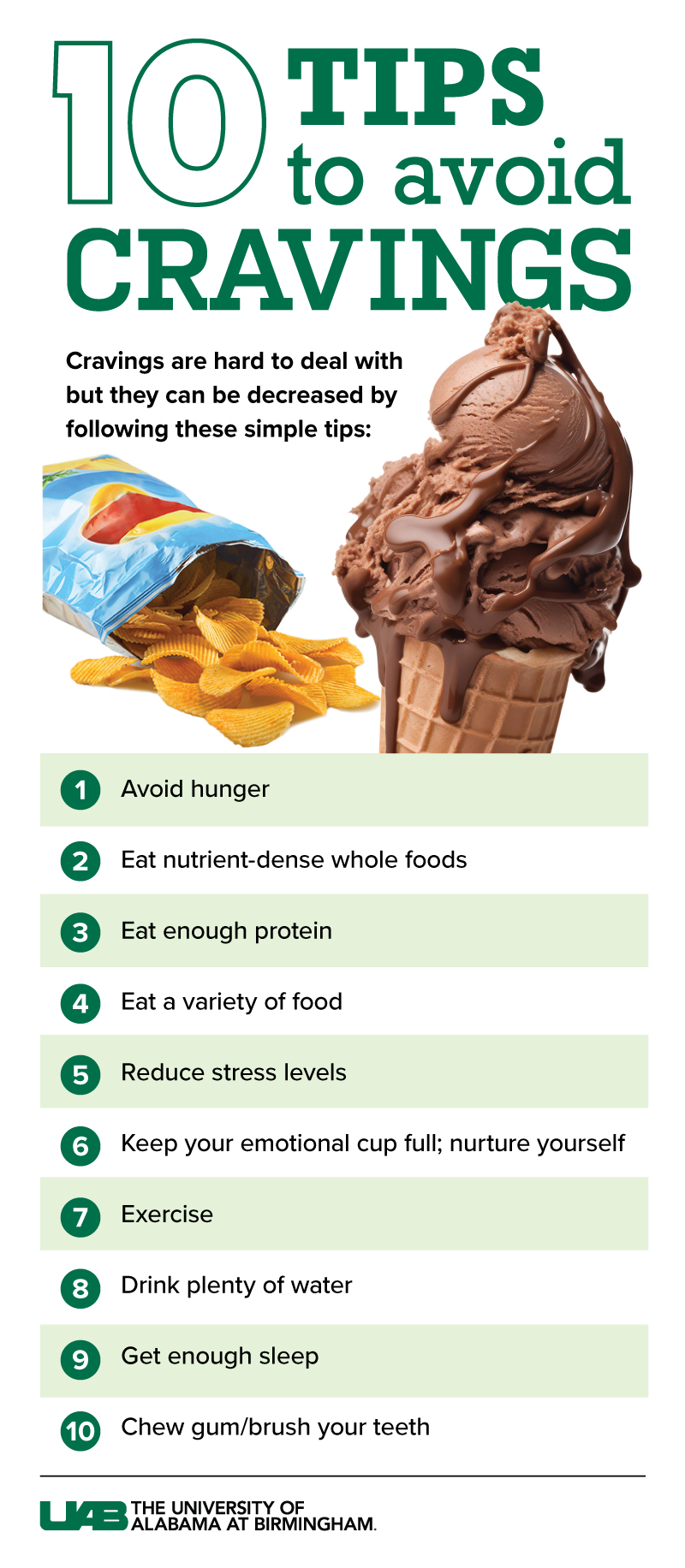 Holly Wyatt, Ph.D.Ever craved ice cream, chocolate, a bag of potato chips or something creamy? Over 90 percent of adults experience food cravings, causing them to snack on unhealthy foods high in sugar, salt or fat. Such unnecessary eating leads to a higher body mass index, contributing to weight gain in people with frequent cravings.
Holly Wyatt, Ph.D.Ever craved ice cream, chocolate, a bag of potato chips or something creamy? Over 90 percent of adults experience food cravings, causing them to snack on unhealthy foods high in sugar, salt or fat. Such unnecessary eating leads to a higher body mass index, contributing to weight gain in people with frequent cravings.
Holly Wyatt, M.D., weight loss expert and professor in the Department of Nutrition Science at the University of Alabama at Birmingham School of Health Professions, explains what a craving is, its causes, and tips to avoid and treat them.
What is a craving?
Craving is an intense desire to eat a specific food or food type that seems urgent and difficult to resist.
“A person experiencing a craving may feel as if they cannot satisfy their hunger until they eat the food they are craving,” Wyatt said.
According to her, cravings are extremely common; females experience more food cravings than do men. While men usually crave savory foods such as meats and eggs, women generally crave sweets such as chocolate or ice cream.
Popular or commonly craved foods include:
- Chocolate chip cookies
- Macaroni and cheese
- Chocolate candy or ice cream bars
- French fries and potato chips
It is important to note that cravings are not synonymous with addiction because craving, as opposed to addiction, does not involve dependence, loss of control and discomfort upon withdrawal.
What causes a craving?
There is limited data to pin down one reason for craving foods, Wyatt says. A craving episode activates specific brain regions responsible for memory, pleasure or reward.
“Cravings can be due to many reasons,” Wyatt said. “They can be out of nowhere. Sometimes, seeing, smelling or hearing about a certain food can cause a craving. They can be because the body needs a specific nutrient or hormonal fluctuations across menstrual cycles.”
An imbalance of hormones such as serotonin, a mood regulation hormone, and leptin, a food and energy expenditure regulating hormone, can also cause a craving.
 Graphic by Jody PotterTips to avoid cravings
Graphic by Jody PotterTips to avoid cravings
Cravings are hard to deal with, but they can be decreased by following these simple tips:
- Avoid hunger
- Eat nutrient-dense, whole foods
- Eat enough protein
- Eat a variety of food
- Reduce stress levels
- Keep your emotional cup full; nurture yourself
- Exercise
- Drink plenty of water
- Get enough sleep
- Chew gum or brush your teeth
How to treat a craving
While preventing cravings is the best approach, knowing how to respond when they happen is equally important. People who have dietary restrictions may experience more cravings than their counterparts.
According to Wyatt, whether a person should act on the craving depends on its frequency and the level of control the person has once they begin eating.
“People who can stop after eating just one serving of chocolate and find it satisfies the craving and improves the mood should eat it by all means,” Wyatt said. “However, for people who cannot resist eating the whole pack, we need a plan B.”
Here is what Wyatt suggests for people whose cravings are hard to satisfy:
- Differentiate between hunger and craving. “Opposite to hunger, cravings take place when you have recently eaten, and the good feeling of satisfying them lasts for only a short period of time,” Wyatt said. “They are stronger when trying to limit calories and frequently caused by stressful situations.”
- Eat low-energy-density foods. “Go for volume and veggies, sit down and slow down when eating, and trust that you will get full,” Wyatt said. Drink water. “If you have a craving, drink 16 ounces of water; it is possible your craving won’t persist after that,” Wyatt said.
- Wait, distract and exercise. “Because cravings are transient, meaning that they pass after some time, wait for at least 15 minutes. Do something enjoyable, or go for a walk,” Wyatt said.
- Educate yourself. “Try to learn what is causing the craving, and try to be mindful the next time it happens,” Wyatt said.
- Pick a healthier substitute. “Eating something that will satisfy the craving and do the least harm is the way to go,” Wyatt said. “For example, instead of having a bag of potato chips when craving something crunchy, eat carrots. If craving something sweet, savory or creamy, go for non-fat Greek yogurt and flavor it. If craving pasta, go for zucchini noodles instead."
What is energy density?
It is the amount of energy generally presented as the number of calories per gram. Low-energy-density foods can help consume a large portion with fewer calories.